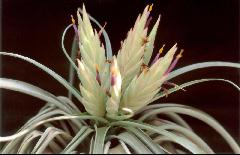
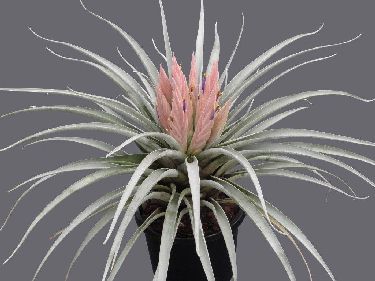
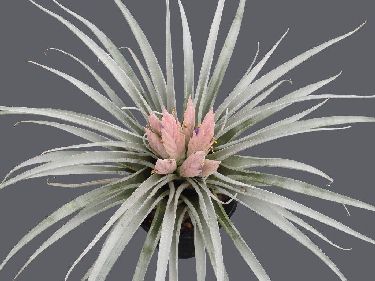
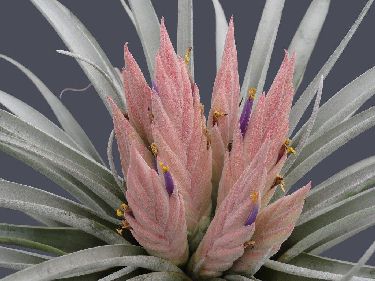
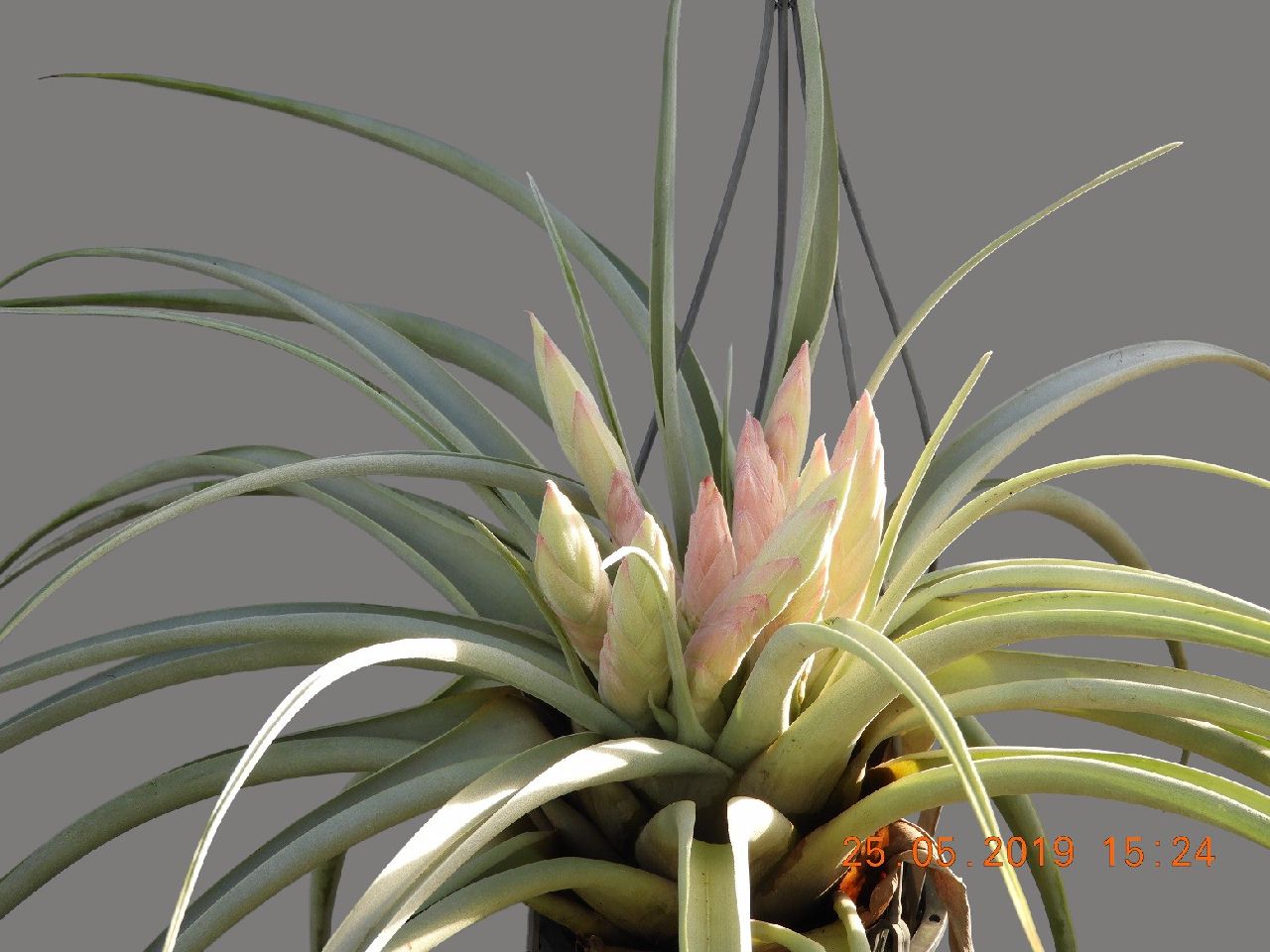
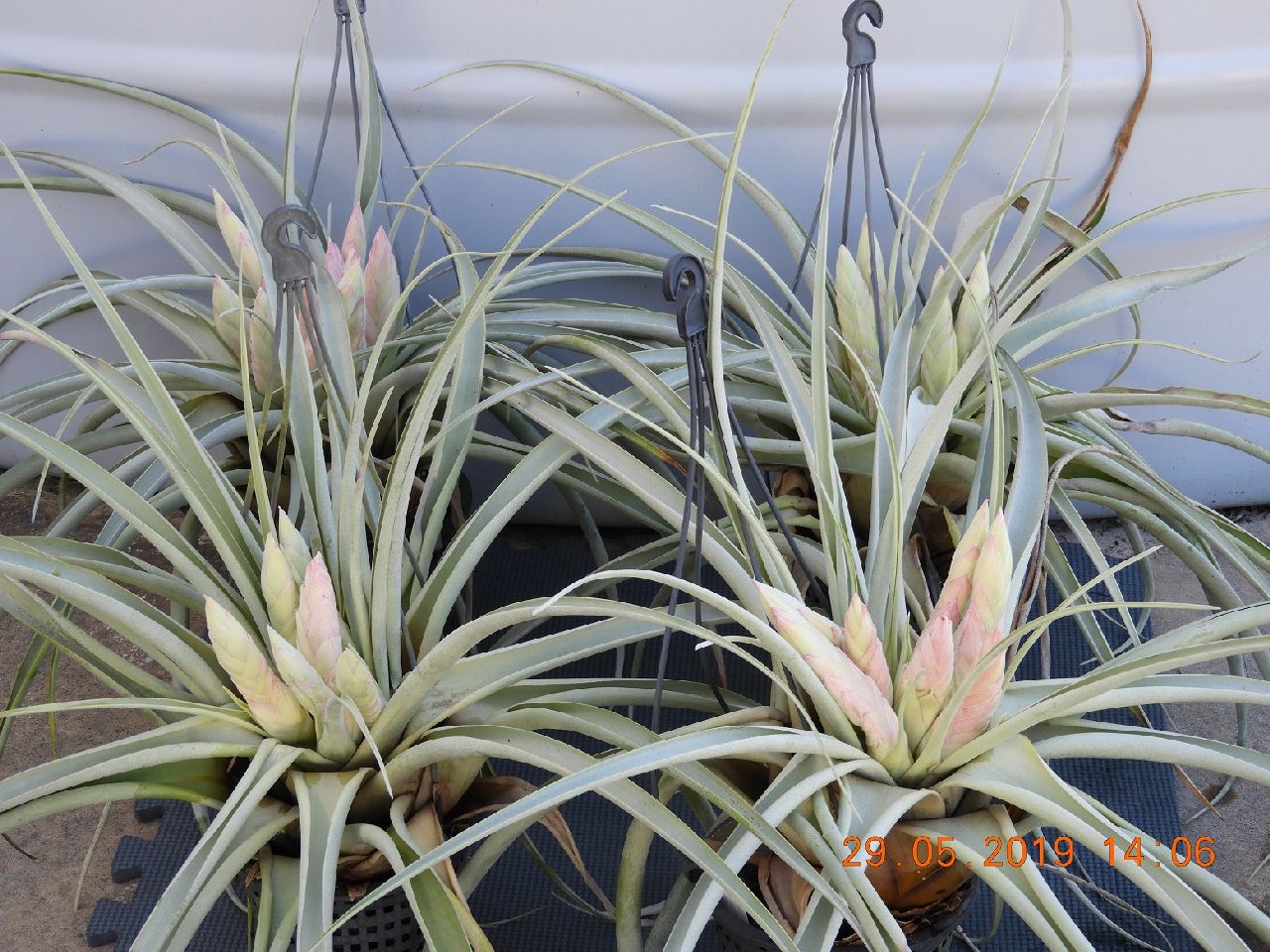
Tillandsia carlsoniae L. B. Smith, Phytologia 7: 1,pl. l, figs. 1,2. 1959.
Desc from S&D p922
Plant stemless, flowering only about 25 cm high.
Leaves many in a spreading rosette, 4 dm long, much exceeding the inflorescence, densely subappressed-lepidote throughout;
Sheaths broadly elliptic, 7-12 cm long, dark castaneous;
Blades straight, narrowly triangular, 25 mm wide, cinereous.
Scape very short, completely hidden by the leaf-bases;
Scape-bracts foliaceous but much reduced, densely imbricate.
Inflorescence densely digitate from 5-6 spikes; (5-15 see below)
Primary bracts broadly ovate with a short linear blade, much shorter than the spikes; Spikes elliptic, acute, 10-12 cm long, 3-4 cm wide, strongly complanate, dense, about 8-flowered with several sterile bracts at base; axis angled, densely lepidote.
Floral bracts elliptic, acute, to 5 cm long, exceeding the sepals, ecarinate, subcoriaceous when dry, roseate, densely cinereous-lepidote;
Flowers short-pedicellate.
Sepals free, lanceolate, acute, 40 mm long, ecarinate, densely cinereous-lepidote;
Petals naked, erect, linear, 6 cm long, dark purple;
Stamens exserted.
Type. Carlson 1697 (holotype US; isotype F), Las Casas to Comitan, Pan American Highway, Chiapas, Mexico, 6 Apr 1949.
DISTRIBUTION. Epiphytic in woods, 1500-2400 m alt, Chiapas, Mexico.
MEXICO. CHIAPAS: Monte Bello, Jan 1952, Carlson 219 (US); Amatanango, 26 Mar 1959, MacDougall 417 (US); Teopisca, 5 Apr 1959, Van Hyning 5915 (US); Comitan, May 1961, Kubisch 10 (US); 29 Apr 1965, Breedlove 9829 (US).
Tillandsia carlsoniae: Profile of an Endemic Species and Its Collector by Robert Guess and Virginia Guess in J. Brom. Soc. 48(5): 207-10. 1998
Plant collecting in the highlands of Chiapas, Mexico, is far different today than it was in 1949 when Dr. Margery C. Carlson traveled to this state on her second botanical expedition for the Chicago Natural History Museum. Accompanied by her friend and colleague, Kate Staley, the two intrepid women spent six months exploring the states of Oaxaca and Chiapas in a fully equipped jeep station wagon. Their collecting sojourn took them along the newly completed Pan American Highway from Oaxaca into Chiapas, through dense rain forests rich with unknown plant species, and on to the Mexico-Guatemala border where they ventured into the nearly inaccessible lake and forest region of Lagos de Montebello. It was on 6 April 1949 during one of their excursions between San Cristobal de Las Casas and Comitan de Dominguez that Dr. Carlson collected a bromeliad later to be described by L.B. Smith (1959:1). Now, with the passage of almost fifty years, only a small percentage of the vast tropical rain and cloud forests of Chiapas where she once collected survives. However, the plant named in her honor, Tillandsia carlsoniae L.B. Smith, still can be found in oak pine forests of the Chiapas Plateau.
T. carlsoniae, one of the more remarkable yet lesser known tillandsias endemic to highland Chiapas, grows at elevations ranging from 1500 to 2400 meters. The sharply tapered leaves, often 40 to 50 centimeters in length and 4 to 5 centimeters wide at their base, are covered with fine scales (trichomes) that reflect light to produce a characteristic silvery-gray color. Like many other scale-covered tillandsias, the leaves of T. carlsoniae lose their light reflective qualities when dampened, and the chlorophyll bearing cells dominate the leaf color until the surface is again dry. The leaf rosette has a distinctive arrangement in which the lower leaves droop markedly in sharp contrast to the semi-erect, spreading upper ones. This pattern facilitates identification of T. carlsoniae at considerable distances. Nestling in this rosette of leaves is the multi-spiked inflorescence which emerges from a very short, hidden scape.
Our observations of the inflorescence differ slightly from previous accounts that describe it as having only five to six pink, laterally flattened spikes (Smith 1959:1; Padilla 1976:84, 1981:20; Smith and Downs 1977:922). In the last few years, we have examined over one hundred plants comprising all stages of development from different highland locales. We conclude that the number of spikes is rarely in this range, but varies from a low of five to as many as fifteen with an average near eleven. This number correlates closer to the nine described by Utley (1994: t 07). In this case, more spikes are better, since the true beauty of this tillandsia comes from the soft-pink color of its floral bracts that are highlighted by small, but dramatic, violet flowers.
A variation of this species found in the same growing range exhibits a longer scape with multiple spikes elevated 8 to 10 centimeters above the cup of the rosette of leaves. The number of spikes is usually the same as in the common form, but the inflorescence appears somewhat less robust in both size and color. We have submitted a specimen to the Bromeliad Identification Center at the Marie Selby Botanical Gardens for another opinion.
Although T. carlsoniae grows in many circumscribed areas of forests around San Cristobal de Las Casas, it is not the bromeliad of choice for decorative use. The indigenous Indians gather it only on special occasions and thus it appears infrequently for sale in local markets. Perhaps because of the delicate hues of the floral bracts and subdued leaf color, it is often overshadowed by the more spectacular highland tillandsias, such as Tillandsia ponderosa and Tillandsia guatemalensis, with their more prominent, red, erect inflorescences. While T. carlsoniae reproduces by seeds as well as multiple offsets, it is still not as abundant as these other highland epiphytes. However, its prolific development of offsets often results in moderately large, isolated clumps of plants in various stages of maturation growing on high tree branches. It was a specimen of this plant that Dr.Carlson submitted to L.B.Smith for identification.
Margery Carlson, who died in 1985 at the age of 92, was a pioneering botanist and one of the few women plant collectors of her time to explore the remote forested areas of Chiapas. Born in 1892, she graduated from Northwestern University in 1916 as the first woman to major in botany, later earned a masters degree and Ph.D. in botany from the University of Wisconsin, and taught in the Department of Biology at Northwestern University for over 30 years. During these years, her five collecting expeditions to El Salvador, Honduras, Costa Rica, Guatemala, and Mexico, resulted in the discovery of numerous new species of epiphytes and other plants. Although she undoubtedly collected many more, Smith and Downs (1974, 1977, 1979) credit her with submitting twenty-five different specimens of Bromeliaceae, nineteen of which came from Chiapas.
In 1958, Dr. Carlson retired from Northwestern University but remained professionally active as a research associate in botany at the Chicago Natural History Museum. Under the aegis of that Institution, she continued her collecting forays into Mexico. Throughout her long and active life, she was an outspoken advocate for the conservation and preservation of wilderness areas in Illinois, an advisor to the Evanston Garden Club, and a member of numerous scientific and environmental organizations. While Knobloch (1983:14) reports her death occurred in Oaxaca, Mexico, articles on her life and accomplishments provided us by Northwestern University Archivist, Patrick Quinn, verify that she died in a retirement home in Evanston, Illinois.
The delightful descriptions of her adventures remind us of a passing time in Mexico, and capture a glimpse of an environment once rich in floral diversity. Of her 1949 trip to Chiapas, she writes: "Many of the pines and oaks in the mountain forests around San Cristobal de Las Casas are as much as a hundred feet tall and eight feet in diameter. A remarkable variety of smaller trees and shrubs forms a dense undergrowth. Trunks and branches bear ferns, orchids, and bromeliads, which live on the moisture of the clouds that gather nightly on the peaks (Carlson and Staley 1953:22)." As a resourceful collector, she made many friends among the local people who admired her tenacity in exploring unknown places under difficult conditions. Her reminiscences about her travels reveal this spirit of adventure. "We (she and Kate Staley) had been gone six months and put nine thousand miles on the jeep, not counting all the miles we had covered on foot. On our three expeditions, one to El Salvador, one to Honduras, and the Chiapas trip, we have collected almost ten thousand plants of 2,600 different species, and are convinced that nothing beats plant collecting for getting to know a country and its people. We are certain that no other gringas have been where we have been, seen what we have seen, or enjoyed Chiapas and its inhabitants as much as we have" (Carlson and Staley 1953:39).
Environmentalists project that within another fifty years, only traces will remain of the majestic tropical forests that once framed the rich collecting ground for Dr.Carlson. Despite this dire prophecy, good memories of times past continue to lure plant collectors and researchers to this region. Even now, people, endowed with the same sense of discovery and curiosity that characterized Dr. Carlson, continue to explore out-of-the-way niches in order to add to the botanical knowledge of Chiapas.